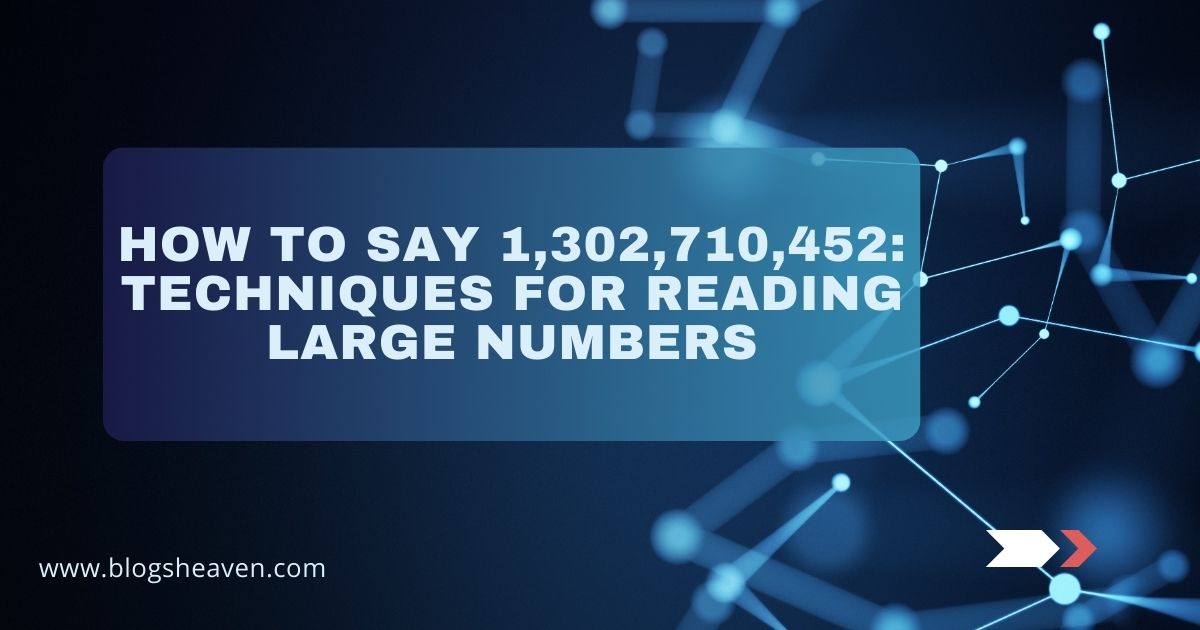Numbers can sometimes feel like a maze to navigate, especially large ones. One particular challenge is understanding how to say complex numbers correctly. In this article, we’ll explore how to pronounce and understand the number 1,302,710,452. Breaking it down can make it much easier to read and interpret. Let’s dive into the details to clear up any confusion and ensure you know exactly how to say it without hesitation.
Breaking Down Large Numbers
Before we focus on our specific number, it’s important to grasp the basic structure of large no.s. Numbers in the billions, millions, and thousands are often grouped in threes for readability, separated by commas. This format helps in distinguishing each section and makes it easier to say the number out loud. Understanding this system is essential for tackling no.s of any size.
Understanding Each Segment of the Number
The number 1,302,710,452 can be divided into three main parts: billions, millions, and thousands. When broken down this way, each segment becomes manageable, allowing us to read the number part by part. Each group of three digits has its own designation—billion, million, and thousand. This is the foundation of correctly reading large no.s.
Reading the Billions Segment
The first part of 1,302,710,452 is “1 billion.” Reading this segment aloud is simple. By focusing on each section, you’ll see that the first digit represents the billion place. So, we start with “one billion,” setting the stage for the rest of the number.
Understanding the Millions Segment
Next, let’s look at the middle part of the number: “302,710.” This part falls into the million category. Here, “302 million” serves as the correct way to begin this section. Understanding that this segment follows the billions makes it clear that “three hundred two million” comes after the “one billion” we already covered.
Interpreting the Thousands Segment
Now we move to the “710” in “710,452.” This part is read as “seven hundred ten thousand.” The thousands segment is critical because it connects the millions and the final part of the number, the hundreds. Saying “seven hundred ten thousand” completes the middle section and leads us into the final part.
Deciphering the Hundreds, Tens, and Units
The last three digits of our number are “452.” This part is the easiest to read since it involves hundreds, tens, and units, which most people are familiar with. Saying “four hundred fifty-two” finishes the number. Now we have all the parts to say the number fluently.
Putting It All Together
After examining each segment, we’re ready to say the entire number smoothly: “One billion, three hundred two million, seven hundred ten thousand, four hundred fifty-two.” By combining each section carefully, the number becomes far less intimidating.
Tips for Saying Large Numbers
Breaking a large number down into its sections is key. Focus on billions, millions, thousands, and smaller units one at a time. Reading each part separately helps avoid overwhelm and ensures accuracy. This method not only improves clarity but also boosts confidence when dealing with complex numbers.
Why It’s Important to Pronounce Numbers Correctly
Clear pronunciation of numbers is essential in many fields, including finance, education, and everyday life. Incorrectly saying a large number can lead to misunderstandings or errors. When dealing with contracts, financial reports, or addresses, accuracy is crucial. Pronouncing numbers correctly can prevent costly mistakes.
Practical Applications of Saying Large Numbers
Whether reading a financial statement, making a presentation, or communicating an address, understanding how to say large numbers is useful. Clear communication of numbers enhances your credibility and shows that you have command over the material. It’s an essential skill in both professional and personal settings.
Learning Numbers Through Practice
The more you practice saying large numbers, the more comfortable you’ll become. Start by practicing with smaller numbers, then work your way up. Soon, numbers like 1,302,710,452 won’t seem as daunting. Like any skill, saying numbers gets easier with repetition and familiarity.
Common Mistakes and How to Avoid Them
One common error is confusing thousands with millions, especially in numbers with similar digits. Practice breaking down numbers slowly and saying each segment out loud. Another mistake is rushing, which can lead to skipped segments or mispronunciations. Take your time to ensure accuracy.
Using Commas for Clarity of Numbers
Commas in large numbers serve as visual aids, breaking the number into readable segments. They’re not just for show; they guide us in saying the number correctly. Always use commas when writing large no.s, as they make it easier to read and pronounce each part separately.
Why Context Matters in Numbers Pronunciation
In contexts like finance or data presentation, clarity in pronouncing numbers is vital. Mispronouncing a number in these settings could cause confusion or errors. Context helps determine whether precision is needed, so be extra careful when presenting large figures in critical scenarios.
How Different Cultures Pronounce Numbers
It’s interesting to note that number pronunciation can vary by culture. Some languages group no.s differently or use distinct terms for segments. In English, we use billions, millions, and thousands, but in other languages, the structure might vary. This cultural perspective can influence how no.s are understood worldwide.
The Importance of Repetition and Practice
Just as with learning a new language, repetition is key in mastering number pronunciation. Consistent practice helps solidify your understanding, making large no.s easier to say. Repeating the process with different no.s enhances both confidence and accuracy.
Conclusion
Pronouncing large numbers like 1,302,710,452 doesn’t have to be daunting. By breaking the number into manageable segments—billions, millions, thousands, and smaller units—you can say any number accurately and confidently. Remember, practice makes perfect. With a little repetition and a clear strategy, you’ll soon master the art of saying large n.os with ease.
FAQs
How do I pronounce numbers with more than nine digits?
Break them down into billions, millions, thousands, and smaller units, then read each segment separately.
What’s the easiest way to practice saying large numbers?
Start with smaller no.s and gradually increase their size. Practice in segments to improve fluency.
Why is saying large numbers accurately important?
Accuracy prevents misunderstandings, especially in professional settings, where precision is crucial.
Are there cultural differences in saying large numbers?
Yes, different languages and cultures may structure and pronounce numbers differently, affecting how they’re understood.
How can I avoid mistakes when reading large numbers?
Use commas to segment the number and read each part slowly. Practicing with various examples can also help.











